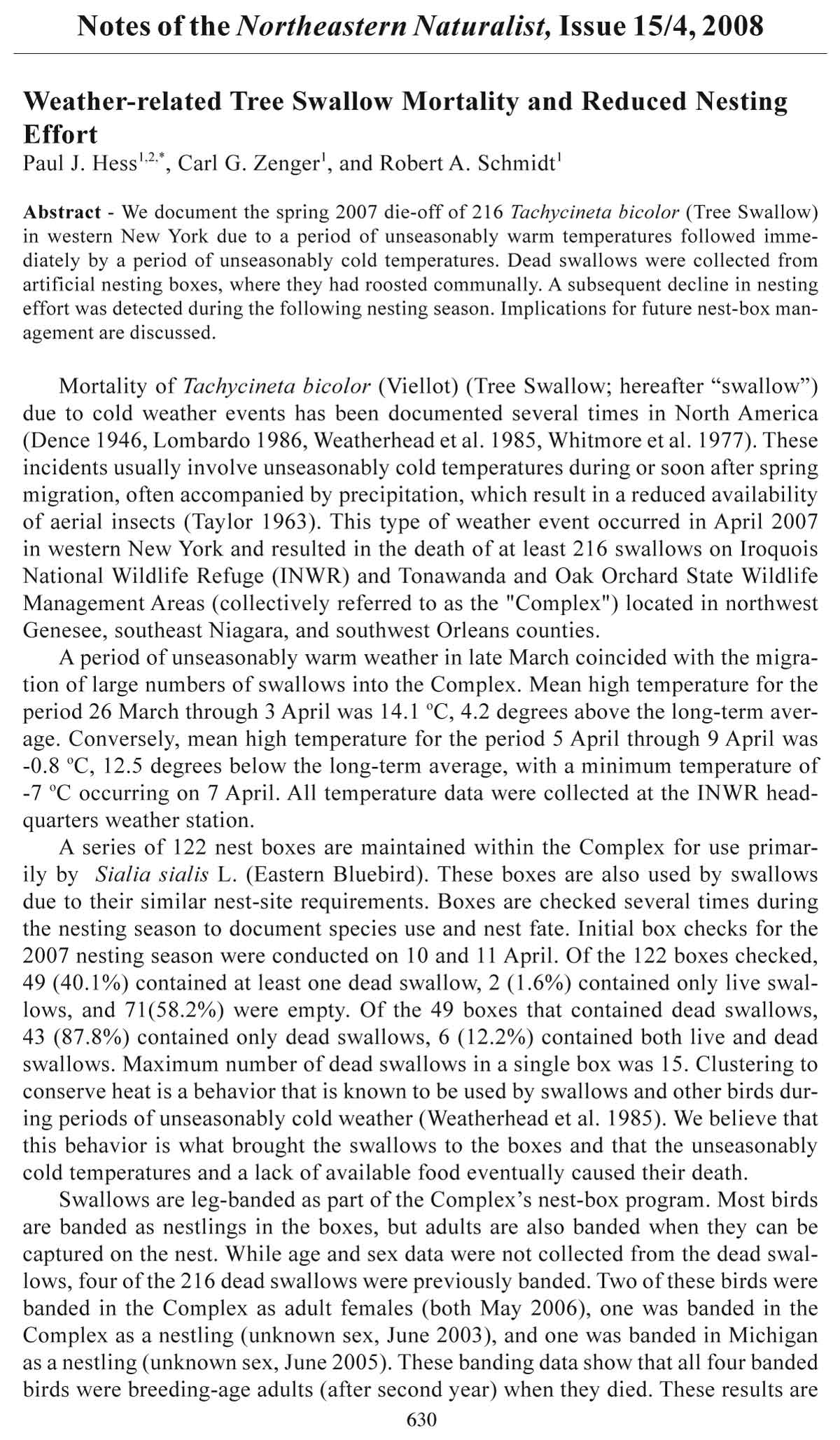Weather-related Tree Swallow Mortality and Reduced Nesting
Effort
Paul J. Hess1,2,*, Carl G. Zenger1, and Robert A. Schmidt1
Abstract - We document the spring 2007 die-off of 216 Tachycineta bicolor (Tree Swallow)
in western New York due to a period of unseasonably warm temperatures followed immediately
by a period of unseasonably cold temperatures. Dead swallows were collected from
artificial nesting boxes, where they had roosted communally. A subsequent decline in nesting
effort was detected during the following nesting season. Implications for future nest-box management
are discussed.
Mortality of Tachycineta bicolor (Viellot) (Tree Swallow; hereafter “swallow”)
due to cold weather events has been documented several times in North America
(Dence 1946, Lombardo 1986, Weatherhead et al. 1985, Whitmore et al. 1977). These
incidents usually involve unseasonably cold temperatures during or soon after spring
migration, often accompanied by precipitation, which result in a reduced availability
of aerial insects (Taylor 1963). This type of weather event occurred in April 2007
in western New York and resulted in the death of at least 216 swallows on Iroquois
National Wildlife Refuge (INWR) and Tonawanda and Oak Orchard State Wildlife
Management Areas (collectively referred to as the "Complex") located in northwest
Genesee, southeast Niagara, and southwest Orleans counties.
A period of unseasonably warm weather in late March coincided with the migration
of large numbers of swallows into the Complex. Mean high temperature for the
period 26 March through 3 April was 14.1 oC, 4.2 degrees above the long-term average.
Conversely, mean high temperature for the period 5 April through 9 April was
-0.8 oC, 12.5 degrees below the long-term average, with a minimum temperature of
-7 oC occurring on 7 April. All temperature data were collected at the INWR headquarters
weather station.
A series of 122 nest boxes are maintained within the Complex for use primarily
by Sialia sialis L. (Eastern Bluebird). These boxes are also used by swallows
due to their similar nest-site requirements. Boxes are checked several times during
the nesting season to document species use and nest fate. Initial box checks for the
2007 nesting season were conducted on 10 and 11 April. Of the 122 boxes checked,
49 (40.1%) contained at least one dead swallow, 2 (1.6%) contained only live swallows,
and 71(58.2%) were empty. Of the 49 boxes that contained dead swallows,
43 (87.8%) contained only dead swallows, 6 (12.2%) contained both live and dead
swallows. Maximum number of dead swallows in a single box was 15. Clustering to
conserve heat is a behavior that is known to be used by swallows and other birds during
periods of unseasonably cold weather (Weatherhead et al. 1985). We believe that
this behavior is what brought the swallows to the boxes and that the unseasonably
cold temperatures and a lack of available food eventually caused their death.
Swallows are leg-banded as part of the Complex’s nest-box program. Most birds
are banded as nestlings in the boxes, but adults are also banded when they can be
captured on the nest. While age and sex data were not collected from the dead swallows,
four of the 216 dead swallows were previously banded. Two of these birds were
banded in the Complex as adult females (both May 2006), one was banded in the
Complex as a nestling (unknown sex, June 2003), and one was banded in Michigan
as a nestling (unknown sex, June 2005). These banding data show that all four banded
birds were breeding-age adults (after second year) when they died. These results are
Notes of the Northeastern Nat u ral ist, Issue 15/4, 2008
630
2008 Northeastern Naturalist Notes 631
different from the findings of Lombardo (1986), where 70% of the dead birds he
found were yearling females.
Swallow nesting effort in the Complex declined in 2007. Total swallow nesting
attempts in boxes was 76, an 18.8 percent decrease from the 93 attempts recorded in
2006. From 2002 through 2006, the number of swallow nest attempts ranged from a
low of 87 to a high of 98 (mean = 91.8, SD = 4.2). The 76 attempts in 2007 were a
decline from the previous five-year average. This decline may suggest that the die-off
had a negative effect on the 2007 swallow nesting effort; however, sufficient banding
data are lacking to draw any definitive conclusions.
Due to the rarity of their occurrence, mortality events such as this are unlikely to
have a long-term negative effect on local swallow populations. If the frequency of
these events were to increase, a local swallow population could experience a decline.
Managers of nest-box programs interested in providing communal roost sites should
consider adding roosting boxes designed specifically for this purpose to their nestbox
trails.
Acknowledgments. We thank Sheila Hess of Ducks Unlimited, Sue Adamowicz of
the US Fish and Wildlife Service, and an anonymous reviewer for the helpful comments
received in their review of this manuscript.
Literature Cited
Dence, W.A. 1946. Tree Swallow mortality from exposure during unseasonable weather. The
Auk 63:440.
Lombardo, M.P. 1986. Yearling-biased female mortality in Tree Swallows. The Condor
88:520–521.
Taylor, L.R. 1963. Analysis of the effect of temperature on insects in flight. Journal of Animal
Ecology 32:99–117.
Weatherhead, P.J., S.G. Sealy, and R.M.R. Barclay. 1985. Risks of clustering in thermally
stressed swallows. The Condor 87:443–444.
Whitmore, R.C., J.A. Mosher, and H.H. Frost. 1977. Spring migrant mortality during unseasonable
weather. The Auk 94:778–781.
1Iroquois National Wildlife Refuge, 1101 Casey Road, Basom, NY 14013. 2Current address
- Ducks Unlimited, 1220 Eisenhower Place, Ann Arbor, MI 48108. *Corresponding author -
phess@ducks.org.












